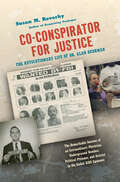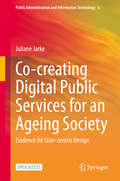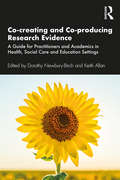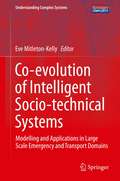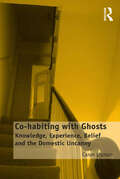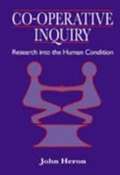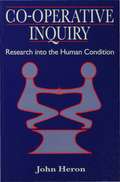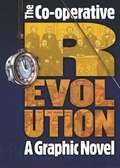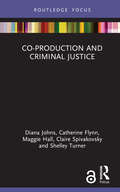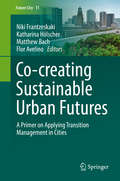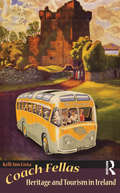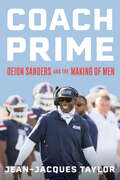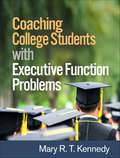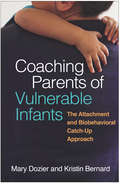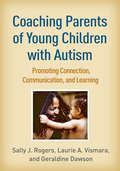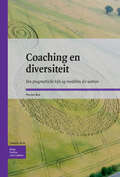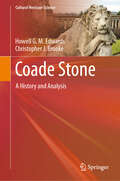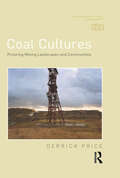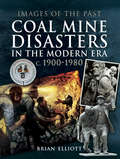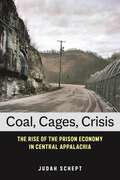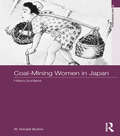- Table View
- List View
Co-conspirator for Justice: The Revolutionary Life of Dr. Alan Berkman (Justice, Power, and Politics)
by Susan M. ReverbyAlan Berkman (1945–2009) was no campus radical in the mid-1960s; he was a promising Ivy League student, football player, Eagle Scout, and fraternity president. But when he was a medical student and doctor, his politics began to change, and soon he was providing covert care to members of revolutionary groups like the Weather Underground and becoming increasingly radicalized by his experiences at the Wounded Knee takeover, at the Attica Prison uprising, and at health clinics for the poor. When the government went after him, he went underground and participated in bombings of government buildings. He was eventually captured and served eight years in some of America's worst penitentiaries, barely surviving two rounds of cancer. After his release in 1992, he returned to medical practice and became an HIV/AIDS physician, teacher, and global health activist. In the final years of his life, he successfully worked to change U.S. policy, making AIDS treatment more widely available in the global south and saving millions of lives around the world.Using Berkman's unfinished prison memoir, FBI records, letters, and hundreds of interviews, Susan M. Reverby sheds fascinating light on questions of political violence and revolutionary zeal in her account of Berkman's extraordinary transformation from doctor to co-conspirator for justice.
Co-creating Digital Public Services for an Ageing Society: Evidence for User-centric Design (Public Administration and Information Technology #6)
by Juliane JarkeThis open access book attends to the co-creation of digital public services for ageing societies. Increasingly public services are provided in digital form; their uptake however remains well below expectations. In particular, amongst older adults the need for public services is high, while at the same time the uptake of digital services is lower than the population average. One of the reasons is that many digital public services (or e-services) do not respond well to the life worlds, use contexts and use practices of its target audiences. This book argues that when older adults are involved in the process of identifying, conceptualising, and designing digital public services, these services become more relevant and meaningful.The book describes and compares three co-creation projects that were conducted in two European cities, Bremen and Zaragoza, as part of a larger EU-funded innovation project. The first part of the book traces the origins of co-creation to three distinct domains, in which co-creation has become an equally important approach with different understandings of what it is and entails: (1) the co-production of public services, (2) the co-design of information systems and (3) the civic use of open data. The second part of the book analyses how decisions about a co-creation project’s governance structure, its scope of action, its choice of methods, its alignment with strategic policies and its embedding in existing public information infrastructures impact on the process and its results. The final part of the book identifies key challenges to co-creation and provides a more general assessment of what co-creation may achieve, where the most promising areas of application may be and where it probably does not match with the contingent requirements of digital public services. Contributing to current discourses on digital citizenship in ageing societies and user-centric design, this book is useful for researchers and practitioners interested in co-creation, public sector innovation, open government, ageing and digital technologies, citizen engagement and civic participation in socio-technical innovation.
Co-creating and Co-producing Research Evidence: A Guide for Practitioners and Academics in Health, Social Care and Education Settings
by Keith Allan Dorothy Newbury-BirchThe importance of a strong evidence-base is widely recognised in contemporary health, social care and education practice, meaning that there is a real need for research which can be quickly and easily translated into real world situations. Research co-produced by practitioners and academics from early stages to end results can draw on each party’s knowledge and experience, in order to create high quality evidence that is relevant and appropriate to practice needs. This guide introduces the basics of co-producing research, looking at the evidence for co-produced research and outlining its theoretical underpinnings, as well as discussing barriers and facilitators to consider. It includes a practitioner perspective and an academic perspective on the benefits and challenges of co-produced research. The substantive chapters are each co-written by an academic and practitioner team and give examples of work carried out – and lessons learned – in public health, education and criminal justice settings. Key learning points are included throughout and drawn together to comprise a toolkit at the end of the book. This book teaches academics and practitioners more about how they can find practical evidence-based answers to complex questions.
Co-evolution of Intelligent Socio-technical Systems: Modelling and Applications in Large Scale Emergency and Transport Domains (Understanding Complex Systems)
by Evangelia Mitleton-KellyAs the interconnectivity between humans through technical devices is becoming ubiquitous, the next step is already in the making: ambient intelligence, i.e. smart (technical) environments, which will eventually play the same active role in communication as the human players, leading to a co-evolution in all domains where real-time communication is essential. This topical volume, based on the findings of the Socionical European research project, gives equal attention to two highly relevant domains of applications: transport, specifically traffic, dynamics from the viewpoint of a socio-technical interaction and evacuation scenarios for large-scale emergency situations. Care was taken to investigate as much as possible the limits of scalability and to combine the modeling using complex systems science approaches with relevant data analysis.
Co-habiting with Ghosts: Knowledge, Experience, Belief and the Domestic Uncanny
by Caron LipmanHow does it feel to live in a ’haunted home’? How do people negotiate their everyday lives with the experience of uncanny, anomalous or strange events within the domestic interior? What do such experiences reveal of the intersection between the material, immaterial and temporal within the home? How do people interpret, share and narrate experiences which are uncertain and unpredictable? What does this reveal about contested beliefs and different forms of knowledge? And about how people ’co-habit’ with ghosts, a distinctive self - other relationship within such close quarters? This book sets out to explore these questions. It applies a non-reductive middle-ground approach which steers beyond an uncritical exploration of supernatural experiences without explaining them away by recourse only to wider social and cultural contexts. The book attends to the ways in which households in England and Wales understand their experience of haunting in relation to ideas of subjectivity, gender, materiality, memory, knowledge and belief. It explores home as a place both dynamic and differentiated, illuminating the complexity of ’everyday’ experience - the familiarity of the strange as well as the strangeness of the familiar - and the ways in which home continues to be configured as a distinctive space.
Co-operative Inquiry: Research Into The Human Condition
by John HeronThis is the first book to provide a comprehensive account of co-operative inquiry: a way of doing research with people where the roles of researcher and subject are integrated. Co-operative inquiry is a distinctive and wide-ranging form of participative research in which people use the full range of their sensibilities to inquire together into any aspect of the human condition. This book offers both an extensive exploration of its theoretical background and a detailed practical guide to the methods involved. Topics covered include: a critique of established research techniques; the underlying participative paradigm of co-operative inquiry; the epistemological and political aspects of participation; different types of co-operative inquiry and the range of inquiry topics; ways of setting up inquiry groups and enabling their development; four kinds of inquiry outcome and the primacy of the practical; the main stages of the inquiry cycle, highlighting key issues for practice at each stage; and special skills and procedures used for enhancing validity.
Co-operative Inquiry: Research into the Human Condition
by John HeronThis is the first book to provide a comprehensive account of co-operative inquiry: a way of doing research "with" people where the roles of researcher and subject are integrated. Co-operative inquiry is a distinctive and wide-ranging form of participative research in which people use the full range of their sensibilities to inquire together into any aspect of the human condition. This book offers both an extensive exploration of its theoretical background and a detailed practical guide to the methods involved. Topics covered include: a critique of established research techniques; the underlying participative paradigm of co-operative inquiry; the epistemological and political aspects of participation; different types of co-operative inquiry and the range of inquiry topics; ways of setting up inquiry groups and enabling their development; four kinds of inquiry outcome and the primacy of the practical; the main stages of the inquiry cycle, highlighting key issues for practice at each stage; and special skills and procedures used for enhancing validity.
Co-operative Revolution
by PolypAs the dominant economic system is increasingly called into question, the time of the co-operative has well and truly come. Illustrating the history of the co-operative movement from its humble beginnings in the north of England to a worldwide network, this graphic novel presents a robust foundation for future well-being. Using a range of styles and cartoon pastiches, Polyp brings to life ideas and people who are rebooting a sustainable economy.Radical cartoonist and activist Polyp has worked with campaigning organizations around the world for over fifteen years. He lives and works in a co-operative housing complex in Manchester, England. <P><P> <i>Advisory: Bookshare has learned that this book offers only partial accessibility. We have kept it in the collection because it is useful for some of our members. Benetech is actively working on projects to improve accessibility issues such as these.</i>
Co-operative Revolution (Kindle Edition)
by PolypAs the dominant economic system is increasingly called into question, the time of the co-operative has well and truly come. Illustrating the history of the co-operative movement from its humble beginnings in the north of England to a worldwide network, this graphic novel presents a robust foundation for future well-being. Using a range of styles and cartoon pastiches, Polyp brings to life ideas and people who are rebooting a sustainable economy.Radical cartoonist and activist Polyp has worked with campaigning organizations around the world for over fifteen years. He lives and works in a co-operative housing complex in Manchester, England. <P><P> <i>Advisory: Bookshare has learned that this book offers only partial accessibility. We have kept it in the collection because it is useful for some of our members. Benetech is actively working on projects to improve accessibility issues such as these.</i>
Co-producing Knowledge for Sustainable Cities: Joining Forces for Change (Routledge Research in Sustainable Urbanism)
by Merritt PolkAt the current time, many issues and problems within sustainable urban development are managed within traditional disciplinary and organizational structures. However, problems such as, climate change, resource constraints, poverty and social tensions all exceed current compartmentalization of policy-making, administration and knowledge production. This book provides a better understanding of how researchers and practitioners together can co-produce knowledge to better contribute to solving the complex challenges of reaching sustainable urban futures. It is written for academic and professional audiences working with urban planning and sustainable cities around the world. Co-producing Knowledge is presented, by way of introduction, as a non-linear, collaborative approach to knowledge production which combines interdisciplinary, transdisciplinary, cross sector and policy approaches to societal problem solving. Examples are taken from Cape Town, Gothenburg, Kisumu, Manchester, Melbourne and a selection of cities in Southeast Asia. Each city chapter discusses the drivers and motivations behind knowledge co-production and gives concrete examples of activities and approaches that have been used to promote sustainable urban futures. Each chapter is written to promote mutual learning from the approaches that are already in use. Building upon these city cases, the conclusions outline an international practice and research agenda aimed at strengthening the promotion and implementation of the knowledge co-production for sustainability across diverse urban development contexts. This book provides an overview of the diverse driving forces behind co-production, and their specific contexts and constraints in a variety of cosmopolitan urban contexts. Some of these include institutional and cross-sector barriers to co-production, the need for learning across diverse levels and contexts, and strategies for balancing scientific excellence with the needs of societal change. This book offers valuable lessons regarding the concrete implications and potential impact that co-production processes can have for different user groups, such as planners, politicians, researchers, business interests and NGOs in different urban development contexts.
Co-production and Criminal Justice (Criminology in Focus)
by Maggie Hall Claire Spivakovsky Catherine Flynn Diana Johns Shelley TurnerThis book explores practical examples of co-production in criminal justice research and practice. Through a series of seven case studies, the authors examine what people do when they co-produce knowledge in criminal justice contexts: in prisons and youth detention centres; with criminalised women; from practitioners’ perspectives; and with First Nations communities. Co-production holds a promise: that people whose lives are entangled in the criminal justice system can be valued as participants and partners, helping to shape how the system works. But how realistic is it to imagine criminal justice "service users" participating, partnering, and sharing genuine decision-making power with those explicitly holding power over them? Taking a sophisticated yet accessible theoretical approach, the authors consider issues of power, hierarchy, and different ways of knowing to understand the perils and possibilities of co-production under the shadow of "justice". In exploring these complexities, this book brings cautious optimism to co-production partners and project leaders. The book provides a foundational text for scholars and practitioners seeking to apply co-production principles in their research and practice. With stories from Australia, the United Kingdom, and Ireland, the text will appeal to the international community. For students of criminology and social work, the book’s critical insights will enhance their work in the field.
Co-creating Sustainable Urban Futures: A Primer on Applying Transition Management in Cities (Future City #11)
by Niki Frantzeskaki Katharina Hölscher Matthew Bach Flor AvelinoThis is a unique book that provides rich knowledge on how to understand and actively contribute to urban sustainability transitions. The book combines theoretical frameworks and tools with practical experiences on transition management as a framework that supports urban planning and governance towards sustainability. The book offers the opportunity to become actively engaged in working towards sustainable futures of cities. Readers of this book will be equipped to understand the complexity of urban sustainability transitions and diagnose persistent unsustainability problems in cities. Urban planners and professionals will build competences for designing transition management processes in cities and engaging with multidisciplinary knowledge in solution-seeking processes. The heart of the book marks the variety of very different local case studies across the world - including, amongst others, Rotterdam in the Netherlands, La Botija in Honduras, Sydney in Australia and Cleveland in the US. These rich studies give inspiration and practical insights to young planners on how to create sustainable urban futures in collaboration with other stakeholders. The case studies and critical reflections on applications of transition management in cities offer food for thought and welcome criticism. They also introduce new lenses to understand the bigger picture that co-creation dynamics play in terms of power, (dis-)empowerment, legitimacy and changing actor roles. This will equip the readers with a deep understanding of the dynamics, opportunities and challenges present in urban contexts and urban sustainability transitions.
Coach Fellas: Heritage and Tourism in Ireland (Heritage, Tourism, and Community #2)
by Kelli Ann CostaThe Coach Fellas are known to almost all tourists who traverse the Irish countryside. Ostensibly bus drivers, they are also the tour guides who provide the crucial component in the branding of “people, place, and pace” upon which Irish heritage tourism depends. Kelli Costa’s ethnography of these highly trained and informed working class men highlights a previously ignored component of the tourism industry. She also demonstrates their importance in providing a visitor-specific vision of heritage that contrasts with the realities of contemporary economic development.
Coach Prime: Deion Sanders and the Making of Men
by Jean-Jacques TaylorAn exclusive insider account with unprecedented access to Deion Sanders, his staff, and players, who are changing the culture of college football."A highly readable portrait of one of the most exciting coaches in college football." – San Deigo Union-Tribune"You won't find a more competitive person than Coach Prime. At Jackson State, he wanted to dominate and win.... Nothing has changed but the address. He wants to dominate and win a national championship at Colorado." (from Coach Prime)Known for decades as one of the NFL’s most iconic and spectacular playmakers, Deion Sanders remains college football's most intriguing newsmaker. In just three years, he has become the most talked about coach by recruiting elite players to moribund programs and reviving the spirit and pride of forgotten fanbases by winning. Along the way, he’s changing how we think about college sports while rejuvenating whole communities with the national attention that follows him and the fresh commerce a winning culture ignites.First at Jackson State and now at Colorado, Sanders has displayed a knack for leading miraculous turnarounds of once-storied-but-long-irrelevant programs. Television cameras turn up for national broadcasts, gameday attendance skyrockets, economic impact reaches the tens of millions, and NFL scouts take renewed interest.Meanwhile, off the field, Sanders displays an uncanny ability to connect with his players. Weekly chat sessions about life and love are the norm. His unyielding commitment to guiding his players to become exceptional men raises the bar on what parents and athletes expect from college coaches.Now, with access no other reporter has been granted, veteran sports journalist Jean-Jacques Taylor takes readers inside one season with Deion Sanders to show the heart, mind, and culture of America's most innovative football coach and his team of would-be champions.
Coaching College Students with Executive Function Problems
by Mary R. Kennedy Mckay Moore SohlbergAlthough executive function difficulties are often addressed in school-age children, there are few resources showing how to help these individuals when they are older. This book presents a dynamic coaching model that helps college students become self-regulated learners by improving their goal-setting, planning, time management, and organizational skills. Ideal for use with students with attention-deficit/hyperactivity disorder (ADHD), learning disabilities, acquired brain injury, and other challenges, Mary R. T. Kennedy's approach incorporates motivational interviewing and emphasizes practical problem solving. User-friendly features include numerous concrete examples, sample dialogues, and print and online resource listings. In a large-size format for easy photocopying, the book contains 21 reproducible forms. Purchasers get access to a Web page where they can download and print the reproducible materials for repeated use.
Coaching Parents of Vulnerable Infants: The Attachment and Biobehavioral Catch-Up Approach
by Mary Dozier Kristin BernardThis is the authoritative presentation of Attachment and Biobehavioral Catch-Up (ABC), the widely disseminated, evidence-based home-visiting intervention for parents of infants who have experienced adversity, such as homelessness, neglect, or institutional care. Vivid case examples--including one that runs throughout the book--illustrate the importance of responsive parenting for helping children develop secure attachments and key regulatory capacities. Over the course of 10 coaching sessions incorporating extensive in-the-moment comments and video feedback, ABC enhances parents' ability to follow their children’s lead, nurture when children are distressed, and avoid frightening behaviors. In a readable, accessible style, chapters describe adaptations for different populations (high-risk birth parents, foster parents, parents who have adopted internationally, and parents of toddlers) and provide guidelines for training and implementation.
Coaching Parents of Young Children with Autism: Promoting Connection, Communication, and Learning
by Geraldine Dawson Sally J. Rogers Laurie A. VismaraA growing body of evidence supports the benefits of high-quality parent interventions for building social and communication skills in 0- to 5-year-olds with autism spectrum disorder (ASD). How can clinicians coach parents to effectively incorporate learning opportunities into daily routines at home? From preeminent experts, this practical book explores the role of the coach and reviews the "whats," "whys," and "how-tos" of successful collaboration with parents. Topics include structuring coaching sessions, identifying children's needs, facilitating playful engagement, and deepening parents' understanding of how they can boost skills development during everyday activities. Seventeen reproducible handouts and forms include the multipage P-ESDM Infant–Toddler Curriculum Checklist, ideal for use in telehealth assessments. Purchasers get access to a webpage where they can download and print the reproducible materials in a convenient 8 1/2" x 11" size.
Coaching en diversiteit: Een pragmatische kijk op modellen die werken
by Marten BosDiversiteit speelt mee in elke begeleidingsrelatie, om welke groep of persoon het ook gaat. Dat kan heel inspirerend zijn, maar kan ook leiden tot wederzijds onbegrip en conflicten. Voor het omgaan met diversiteit zijn inmiddels heel wat theorieën en methoden ontwikkeld. Maar welke werken nu echt in de praktijk?De auteur van dit boek, Marten Bos, begeleidt zeer uiteenlopende groepen: van allochtone jongeren en politieagenten tot verslaafde prostituees en jonge zakenmensen. Met enkele bestaande modellen kan hij in elke praktijksituatie goed uit de voeten. Coaching en diversiteit biedt daarom niet de zoveelste nieuwe manier van denken, maar werpt nieuw licht op algemene theorieën, aan de hand van veel praktijkvoorbeelden.De auteur legt het begrip diversiteit uit vanuit een brede visie op cultuur, als een waaier van identiteiten. Aan de hand daarvan kan de lezer eigen verhalen en die van cliënten onderzoeken op diversiteit. Het boek sluit af met oefeningen voor het werken met groepen, individuele klanten en organisaties.
Coade Stone: A History and Analysis (Cultural Heritage Science)
by Howell G. Edwards Christopher J. BrookeThe history and nature of artificial stone for use in architecture is a subject still shrouded in myth and misconception. This book aims to lay bare those misconceptions and present a scientific and architectural account of these materials, and especially Coade Stone, the most successful of all, which found great favour during the Georgian period. Many examples of Coade Stone cast sculpture still exist and several key examples are presented in context and as case studies . Eleanor Coade’s artificial stone was so good that many observers could not distinguish it from the natural stone it replaced: the growth in replication of the neo-classical statuary and building adornment required in the late Georgian and Regency period was well satisfied by the use of Coade stone. A holistic evaluation of Coade stone artefacts is undertaken whereby the use of analytical data, historical documentation, invoices, company records, impressed marks and expert connoisseurship will establishthe attribution of Coade stone artefacts, some of which are currently in the unknown category. Several new scientific analyses are presented that demonstrate the true nature of high temperature fired ceramic Coade Stone and allow comparison with other forms of artificial stone, such as the cold cured cementitious variations, which eventually replaced it in the Victorian period.
Coal Cultures: Picturing Mining Landscapes and Communities (Photography, Place, Environment)
by Derrick PriceCoal is the commodity that powered the technologies that made the modern world. It also brought about unique communities marked by a high degree of social solidarity and self-help. Mining was central to working class life, drawing rural populations into industrial labour, but it often took place in picturesque landscapes, so that its black spoil heaps became a central symbol of the degradation of pastoral life by the demands of an extractive industry. Throughout Europe and the USA photographers have pictured the characteristic landscapes of the industry, and continue to do so as strip mining devastates huge areas of land. Not only landscape photography but also documentary, portraiture, photojournalism and art photography have been used in order to portray mines and miners. This book presents three interlinked strands of investigation. The first is the way in which the production of coal created paradigmatic communities grounded in particular landscapes. The second concerns the role of photography in exploring, delineating and critiquing mining communities. This in turn involves an examination of the aesthetic and social characteristics of a number of genres of photography. Lastly, it considers the growth and decline of these sites, the geographic shift of the industry to other places, and the re-presentation of traditional localities through the lens of the heritage industry and industrial tourism.
Coal Mine Disasters in the Modern Era c. 1900–1980 (Images of the Past)
by Brian Elliott&“These haunting images, with well-researched facts, figures and timelines providing context, bring the bygone era of 20th-century coal mining to life.&”—Family Tree Although everyday fatalities in mines was far greater, it was the disasters that encouraged those in power to reform the way in which miners had to work underground, especially with regard to safety. And it would be no exaggeration to say that it was the disasters that greatly contributed to bringing the coal industry into national control. Sadly, for bereaved individuals and families, nothing could really compensate for the loss of one or more of a loved one. The impact of the big disasters, where hundreds of men and boys—one or two generations—were lost, immediately, the impact was massive, and continued to be felt many years afterwards. New and restored disaster memorials bear testimony to the great respect that former mining communities continue to have for their &“lost miners.&” Using many previously unpublished images, and a carefully supportive text, the author provides a detailed overview of mining disasters in the modern era, from the early 1900s to the 1980s. It is the first book of its kind to attempt such a large project in pictorial form with a foreword by Ceri Thompson, curator of the Big Pit, the Welsh national mining museum. The book is published at a particularly poignant time, after the recent closure of Britain&’s last deep coal mine. &“So many remarkable photographs and drawings: The story may be tragic, but it is one that lies at the very heart of the history of coal mining in Britain.&”—WDYTYA? magazine
Coal, Cages, Crisis: The Rise of the Prison Economy in Central Appalachia
by Judah ScheptHow prisons became economic development strategies for rural Appalachian communitiesAs the United States began the project of mass incarceration, rural communities turned to building prisons as a strategy for economic development. More than 350 prisons have been built in the U.S. since 1980, with certain regions of the country accounting for large shares of this dramatic growth. Central Appalachia is one such region; there are eight prisons alone in Eastern Kentucky. If Kentucky were its own country, it would have the seventh highest incarceration rate in the world. In Coal, Cages, Crisis, Judah Schept takes a closer look at this stunning phenomenon, providing insight into prison growth, jail expansion and rising incarceration rates in America’s hinterlands. Drawing on interviews, site visits, and archival research, Schept traces recent prison growth in the region to the rapid decline of its coal industry. He takes us inside this startling transformation occurring in the coalfields, where prisons are often built on top of old coalmines, including mountaintop removal sites, and built into community planning approaches to crises of unemployment, population loss, and declining revenues. By linking prison growth to other sites in this landscape—coal mines, coal waste, landfills, and incinerators—Schept shows that the prison boom has less to do with crime and punishment and much more with the overall extraction, depletion, and waste disposal processes that characterize dominant development strategies for the region.Schept argues that the future of this area now hangs in the balance, detailing recent efforts to oppose its carceral growth. Coal, Cages, Crisis offers invaluable insight into the complex dynamics of mass incarceration that continue to shape Appalachia and the broader United States.
Coal-Mining Women in Japan: Heavy Burdens (Asia's Transformations)
by W. Donald BurtonIn the years Bbetween the Meiji Restoration in 1868 and the beginning of the war mobilization boom in 1930, collieries in Europe and America embraced new technologies and had long since been excluded women from working underground. In Japan, however, mining women witnessed no significant changes in working practices over this period. The availability of the cheap and abundant labor of these women allowed the captains of the coal industry in Japan to avoid expensive investments in new machinery and sophisticated mining methods;, instead, they continued to intensely exploit workers and markets intensively, making substantial profits without the burdens of extensive mechanization. This unique book explores the lives of the thousands of women who labored underground in Japan’s coal mines in the years 1868 to 1930. It examines their working lives, their family lives, their aspirations, achievements and disappointments. Drawing heavily on interview material with the miners themselves, W. Donald Burton combines translations of their stories with features of Japanese society at the time and coal mining technology. In doing so, he presents a complex account of the women’s lives, as well as providing a keen insight intoon gender relations and the industrial and labor history of Japan. Coal Mining Women in Japan will be welcomed by students and scholars of Japanese history, gender studies and industrial history.
Coalition Government Penal Policy 2010-2015: Austerity, Outsourcing and Punishment
by David SkinnsThis book shows how the overall impact of the penal policy agenda of the Coalition Government 2010-2015 has not led to the intended 'rehabilitation revolution', but austerity, outsourcing and punishment, designated here as 'punitive managerialism'. The policy of austerity has led to significant budget cuts in legal aid and court services which threaten justice. It has also led to staffing reductions and overcrowding in the prison system which threaten order and have undermined more positive work with prisoners. The outsourcing of prison and community-based offender services is based on untried method with uncertain results. The shift in orientation towards punishment is regrettable because it is essentially negative. The book notes that this move to punitive managerialism is located in the broader trend towards neo-liberalism. It concludes by attempting to articulate the parameters of an affordable and emotionally satisfying yet humane and rational penal policy. >
Coal’s Final Void: Extracted Futures and the Everyday Making of the Climate Crisis
by Kari DahlgrenThis book explores the continuation of coal mining in Australia despite growing awareness of its contribution to the climate crisis. Through an in-depth ethnographic study, Kari Dahlgren reveals the complex and often contradictory ways that miners, lobbyists, and communities navigate the uncertain future of coal. By focusing on the human stories behind this industry, the book sheds light on broader environmental, political, and social issues of global significance.Dahlgren’s research spans multiple Australian coal communities, primarily in Moranbah, Queensland, and the Hunter Valley of New South Wales. She offers insights into the daily decisions and ethical considerations of coal miners and lobbyists that sustain the industry in the face of climate change. The book addresses diverse topics, such as labour precarity, gender roles, populist politics, and the moral accusations faced by pro-coal advocates, connecting these themes to the broader social and political challenges of Australia’s energy transition.Central to the book are the “final voids” left by mining—both physical and metonymic holes left in the aftermath of mining. These voids represent the emptied livelihoods of those entangled in the coal industry, as they grapple with the uncertainty of what comes next. The book explores how communities, lobbyists, and miners attempt to imagine and fill these voids with hopeful but often impractical visions, avoiding a reckoning with the industry's destructive legacy. This struggle highlights the deep entanglement of labour and ecological precarity in sustaining the climate crisis, offering fresh insights for scholars in anthropology, human geography, and energy policy. This book is essential reading for scholars, policymakers, and activists engaged in climate and energy debates, as well as anyone interested in the complex human dimensions of the energy transition.
